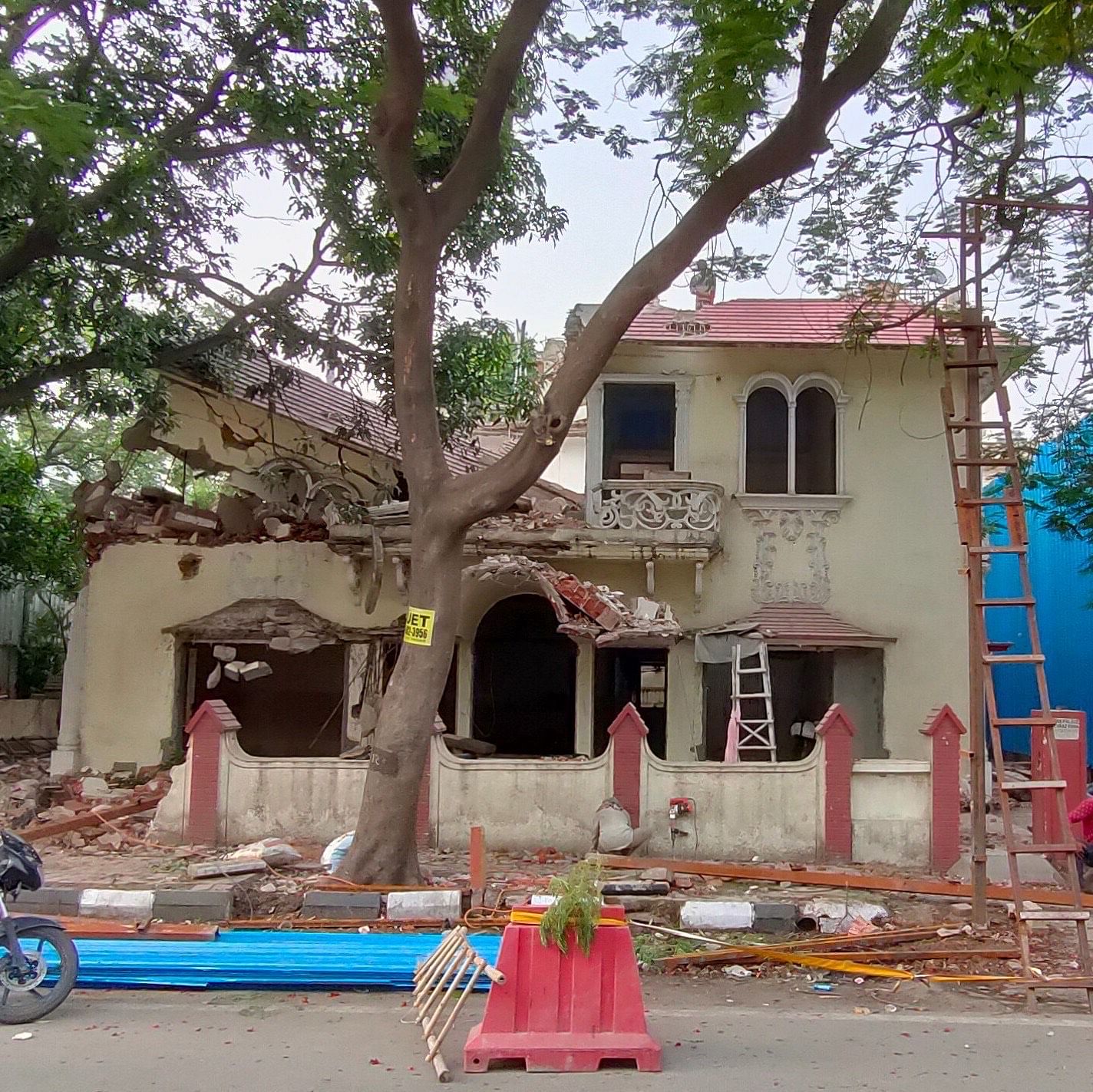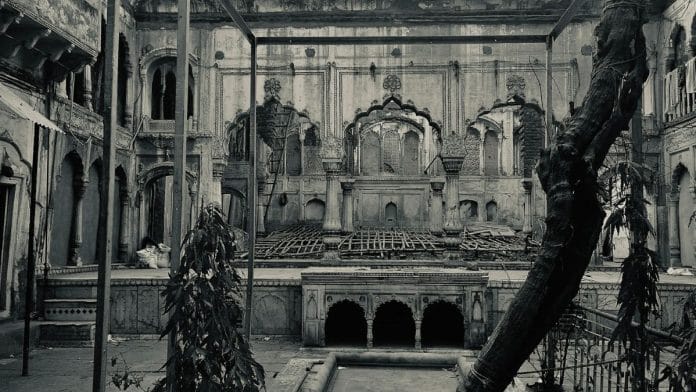New Delhi: A baroque Spanish-inspired house in South Delhi is set to be demolished to make way for a larger property. For archaeologist, curator and art historian Anica Mann—its disappearance is another step toward the “death of architecture in Delhi” and the rise of cookie-cutter, developer-built houses.
Love, loss and longing for the city’s old homes were the central motif of Mann’s presentation during the session ‘Excavating Urbanity’ at the Kiran Nadar Museum of Art earlier this month. She views this transformation as a loss for Delhi’s modern architectural heritage—one that was built post-Independence.
“The memory of the modern is being forgotten, just as the memory of Partition was,” said Mann, who has been archiving and documenting the city’s history from the lens of architecture on her Instagram handle, Delhi Houses. It’s part of a project by the same name that celebrates and preserves the fading memories and the people who shaped it.
The event, which was part of KNMA’s Fabulation Project, included a discussion with social anthropologist Sarover Zaidi and architect Rafiq Kidwai. It could have easily been a nostalgic and maudlin trip down memory lane. Instead, it traced how Delhi’s architecture has evolved to suit the needs of the moment.

The architects of Delhi’s houses made space for the belongings of the families who lived there. They were made to suit women as they were the ones who stayed at home the most. So, they had large storage spaces, dining areas, and speckled terrazzo floors that hid dirt and dust. But now, houses are made for affordable living, they’re cramped spaces that blur the line between living and staying. The trade-off for efficiency and profit is warmth and community that the old homes exuded, said Mann.
Every house has a story to tell—some speak clearly through their architecture, while others invite interpretation through the perceptions of those who see them.
“The drama of the house has been lost,” said Zaidi.
Also read: INA, Candy, Pandara Market—Englishman Nick Booker is teaching Delhiites their own history
Barsatis, courtyards and community
One of the houses Mann featured in her photo presentation was an ornate and grand 17th-century house of the Mughal Period in Old Delhi.
Its arched windows and doorways, intricate carvings, and overall worn-out condition hint at the passage of time, and its historical significance. The overgrown tree, leaning into the courtyard, adds to the sense of abandonment.
The house compels you to imagine the vibrant and lively nights that it once hosted—just like the ones we see in movies. “Perfumed air from ittars would have filled the courtyard, while music and lively chatter echoed through narrow alleyways, tracing the path to the bustling home,” said Mann.
Distinctive courtyards and entrances reflected the architectural grandeur. Courtyards were central to these homes, providing open, airy spaces that offered respite from the heat, and a venue for social gatherings.
“We have lost the courtyards of Delhi houses, which were once integral to the city’s character,” said Mann

She described her visit to an old house on Hanuman Road where an elderly couple holds onto traditions that have been passed down to them. They place Shiuli flowers for idols of Hindu deities in their house. It reflects a deep connection to their cultural and religious practices, which are intertwined in the physical space of their home.
One of the reasons why courtyards are disappearing and houses are becoming more compact is the shift from joint to nuclear families. The new architecture caters to a different set of needs. Legal divisions of property have led to the fragmentation of estates, with families moving to build larger homes in the suburbs, Mann added
“To truly understand Delhi, you need to appreciate what happens on its rooftops,” said Zaidi. Like the courtyard, the rooftop was integral to Delhi’s houses. It’s iconised in Bollywood as well. She gave the example of the movie Delhi 6 where neighbours Abhishek Bachchan and Sonam Kapoor court each other from their respective rooftops. Today, the Delhi barsati, once a common rooftop space, has become a luxury feature.
Houses in Old Delhi were built along narrow alleyways, a deliberate choice by Mughal city planners given the scorching summers. These shaded cool paths led to homes with multiple doorways. They all shared a common feature—two seats framing the entrance. These outdoor seats fostered a sense of community, making walks home a time for greetings and quiet conversations with neighbours.
Also read: Even Tomars and Mughals dumped waste in the Yamuna—Swapna Liddle on Delhi’s water history
Delhi: A home for all
The conversation quickly moved to how displaced families brought remnants of their past, including furniture and other belongings, from Pakistan during the Partition. What’s unique about Delhi is that its architecture reflects the needs and design sensibilities of people from all over India. It speaks to how the national capital embraces and accepts everyone.
The dedication with which families made their homes after Partition, despite having limited resources, is commendable. “They show immense pride in creating such enduring structures,” said Mann
Karl MalteVon Heinz, an Austrian architect, was instrumental in designing homes that catered to these newly settled families. “A period of gracious living,” Mann said about his work. Kidwai pointed out that his influence can still be seen in Jamia’s historic school buildings.
Different communities have naturally settled in specific neighbourhoods, creating vibrant enclaves across the city.
For instance, people from West Bengal have established themselves in areas like CR Park, while those from the Northeast have made Majnu Ka Tilla their home. This pattern of settlement not only reflects the city’s capacity to accommodate diverse groups but also highlights its role as a melting pot where various cultures and occupations intermingle.
Mann noted that despite its vastness and density, Delhi remains welcoming and never too crowded to make room for more. It is a home-like place away from home.
During the audience interaction, a member introduced the idea of the haunted house, homelessness and its relation to Walter Benjamin’s notion of homes haunting us.
“In Japan, there’s a belief that objects, when extensively cared for, can develop a kind of spiritual presence. This is similar to how an old house, rich in history, can feel alive with past experiences. Homelessness might be seen not just as the lack of physical space but as a continuous, haunting absence in one’s life,” Mann responded.
(Edited by Theres Sudeep)






